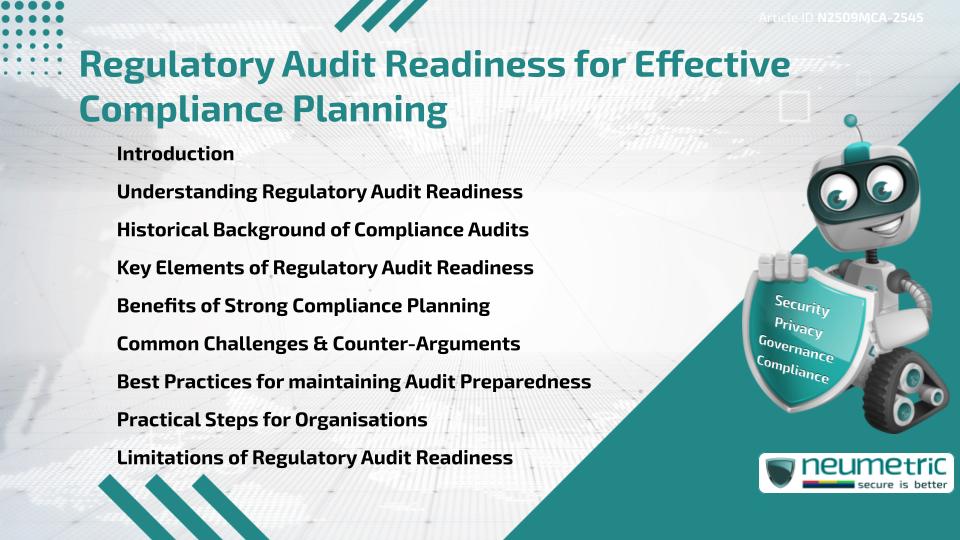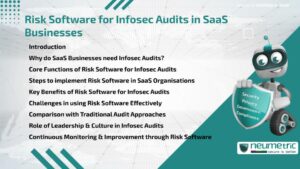Table of Contents
ToggleIntroduction
Regulatory Audit readiness plays a critical role in helping Organisations achieve effective compliance planning. It ensures that companies are prepared for audits, reduce Risks of penalties & maintain trust with Stakeholders. By focusing on regulatory Audit readiness, businesses can streamline internal processes, identify compliance gaps & demonstrate accountability. This preparation not only improves organizational efficiency but also supports long-term operational stability. Understanding how regulatory Audit readiness connects with compliance planning is key for businesses in regulated industries.
Understanding Regulatory Audit Readiness
Regulatory Audit readiness refers to the ability of an organisation to undergo an external or Internal Audit with minimal disruption. It includes having clear documentation, Evidence of adherence to rules & well-trained staff. Just as athletes train continuously to stay fit for competitions, Organisations must consistently maintain compliance systems to be Audit-ready at any given time. This state of preparedness enhances credibility & reduces last-minute stress when audits are announced.
Historical Background of Compliance Audits
Compliance audits have existed for decades, with roots in Financial oversight & corporate Governance. Over time, they expanded to cover environmental regulations, Data Privacy & workplace safety. The rise of international standards such as ISO 27001 & frameworks like HIPAA further highlighted the importance of consistent readiness. Historical missteps, where Organisations faced heavy fines due to poor compliance, underline why Audit preparedness remains essential.
Key Elements of Regulatory Audit Readiness
The foundation of regulatory Audit readiness rests on several pillars:
- Documentation: Comprehensive & up-to-date records are vital.
- Training: Employees must understand compliance responsibilities.
- Monitoring: Regular internal reviews prevent issues from escalating.
- Technology: Automated systems reduce human error & streamline Evidence gathering.
These elements collectively form the backbone of effective compliance planning.
Benefits of Strong Compliance Planning
When Organisations invest in regulatory Audit readiness, they gain multiple benefits:
- Reduced Likelihood of penalties or legal consequences.
- Increased trust with regulators, Customers & investors.
- Improved efficiency through streamlined processes.
- Enhanced Risk Management capabilities.
In short, readiness acts as both a shield & a compass, guiding companies toward sustainable compliance.
Common Challenges & Counter-Arguments
Some argue that constant Audit readiness is resource-intensive. Smaller Organisations often feel that the cost of Continuous Monitoring outweighs the benefits. Others suggest that compliance frameworks can sometimes be rigid, making innovation harder. While these concerns are valid, the long-term Risks of non-compliance — including fines, reputational damage & operational disruptions — generally outweigh the upfront investment required.
Best Practices for maintaining Audit Preparedness
To stay consistently prepared, Organisations can follow these practices:
- Conduct regular mock audits to identify gaps.
- Maintain a centralized compliance repository for easy access.
- Train staff periodically to refresh awareness.
- Leverage compliance management software for efficiency.
- Document Corrective Actions promptly & thoroughly.
These habits build resilience & ensure Audit readiness becomes part of organizational culture.
Practical Steps for Organisations
Implementing regulatory Audit readiness starts with small but consistent actions. Begin with a gap Assessment to identify areas of non-compliance. Develop an action plan with clear timelines & accountability. Assign compliance champions across departments to create ownership. Regularly update Policies to reflect new regulations & encourage transparent communication with auditors. Just like maintaining good health requires regular exercise & balanced nutrition, Audit readiness requires steady commitment & attention.
Limitations of Regulatory Audit Readiness
Despite its importance, regulatory Audit readiness is not a one-size-fits-all solution. Different industries face unique regulations, making it challenging to standardize preparation. Additionally, changing laws require constant vigilance, which can strain resources. Organisations must balance Audit readiness with other strategic priorities to avoid overburdening teams.
Conclusion
Regulatory Audit readiness is more than a checklist; it is a strategic approach to achieving effective compliance planning. By focusing on preparedness, Organisations reduce Risks, improve efficiency & build trust with Stakeholders. While challenges exist, adopting a culture of Continuous Improvement ensures that compliance remains sustainable.
Takeaways
- Regulatory Audit readiness is central to compliance planning.
- It relies on documentation, training, monitoring & technology.
- Challenges exist, but the benefits far outweigh the costs.
- Organisations should embed readiness into daily operations.
FAQ
What is regulatory Audit readiness?
It is the state of being prepared for compliance audits through proper documentation, training, monitoring & system controls.
Why is regulatory Audit readiness important?
It helps Organisations avoid penalties, improve efficiency & demonstrate accountability to regulators & Stakeholders.
How does regulatory Audit readiness improve compliance planning?
It aligns Policies, training & monitoring to ensure that Organisations meet Regulatory Standards consistently.
What are the common challenges in maintaining regulatory Audit readiness?
Challenges include resource constraints, regulatory complexity & the perception that readiness is costly.
Can small Organisations achieve regulatory Audit readiness?
Yes, small Organisations can adopt scalable practices like regular internal reviews & staff training to stay prepared.
What tools can support regulatory Audit readiness?
Compliance management software, centralized repositories & automated Monitoring Tools are useful.
How often should Organisations review their regulatory Audit readiness?
Regular reviews, at least annually or after major regulatory changes, are recommended.
Need help for Security, Privacy, Governance & VAPT?
Neumetric provides organisations the necessary help to achieve their Cybersecurity, Compliance, Governance, Privacy, Certifications & Pentesting needs.
Organisations & Businesses, specifically those which provide SaaS & AI Solutions in the Fintech, BFSI & other regulated sectors, usually need a Cybersecurity Partner for meeting & maintaining the ongoing Security & Privacy needs & requirements of their Enterprise Clients & Privacy conscious Customers.
SOC 2, ISO 27001, ISO 42001, NIST, HIPAA, HECVAT, EU GDPR are some of the Frameworks that are served by Fusion – a SaaS, multimodular, multitenant, centralised, automated, Cybersecurity & Compliance Management system.
Neumetric also provides Expert Services for technical security which covers VAPT for Web Applications, APIs, iOS & Android Mobile Apps, Security Testing for AWS & other Cloud Environments & Cloud Infrastructure & other similar scopes.
Reach out to us by Email or filling out the Contact Form…





